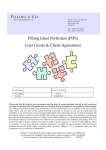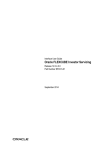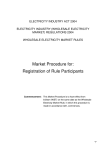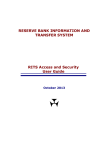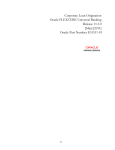Download ASF Standard - Securitisation
Transcript
Australian Securitisation Forum Disclosure and Reporting Standards User Guide Issued: 31 March 2012 Table of Contents 1. Executive Summary ......................................................................................................................... 3 1.1. User Guide............................................................................................................................... 3 1.2. Background ............................................................................................................................. 3 2. 2. Disclosure Standards ................................................................................................................... 5 3. Important Information for Data Compilation and Report Distribution ........................................ 22 3.1. Data Format .......................................................................................................................... 22 3.2. Frequency and Timing ........................................................................................................... 22 3.3. Report Distribution ............................................................................................................... 22 1. Executive Summary 1.1. User Guide This User Guide is designed to assist in the understanding and interpretation of the RMBS and ABS Pre-Issuance Disclosure and Post-Issuance Reporting Standards (the “Standards”). Refer to Table 1 for the full list of Standards. Table 1 – List of ASF Standards covered by the User Guide Standard Reference Standard Title ASF 100.10 RMBS Pre-Issuance Disclosure ASF 100.20 RMBS Securities Information Reporting ASF 100.30 RMBS Pool Information Reporting ASF 100.40 RMBS Loan Level Reporting ASF 200.10 ABS Pre-Issuance Disclosure ASF 200.20 ABS Securities Information Reporting ASF 200.30 ABS Pool Information Reporting ASF 200.40 ABS Static Historical Cumulative Net Loss Reporting This User Guide provides an easy-to-understand explanation and example of each disclosure and reporting data requirement to assist Australian RMBS and ABS issuers to disclose and report in accordance with the Standards. Consistent terminology is used throughout this User Guide and the Standards. The ASF publishes a glossary which provides explanations of many of the terms used. The glossary is available at http://www.securitisation.com.au/ASF_Glossary. Section 4 (‘Important Information for Data Compilation and Report Distribution’) of the User Guide provides technical detail on the data formats required, and is aimed at assisting those who are responsible for extracting, compiling and distributing the data in the Standard format. 1.2. Background The Standards are aimed at providing Australian RMBS and ABS investors, rating agencies, dealers, trustees and other market participants with consistent, comprehensive and timely pre-issuance and post-issuance information and data. The Standards were developed by the Australian Securitisation Forum with reference to reporting standards in other jurisdictions such as the United States and Europe, as well as disclosure principles released by the International Organisation of Securities Commissions. It should be noted that the ABS Standard is aimed at ABS transactions where the asset backing the security is a loan or receivable for an automobile or equipment. It is not intended to be used for disclosure or reporting of commercial mortgage-backed securities (CMBS). The ASF requests that Issuers adopt the Standards for all RMBS and ABS transactions, in the interests of maintaining best practice for securitisation disclosure and reporting, in order to promote the ongoing development of the securitisation market in Australia. 2. Disclosure Standards The pre-issuance disclosures standards are to be incorporated into the offer document the issuer (and related parties) compile and produce when they are marketing RMBS and ABS. Disclosure Item Transaction Name Contact Name Contact Address Contact Telephone Number Contact E-mail Address Responsible Party Relevant Parties to the Transaction Description Example Full name of the transaction. ABC Trustee Ltd as Trustee for Sample Securitisation Trust 2012-1 Name of the department or the point person/s of the information source. Mailing address of the contact of the information source. Telephone number of the contact of the information source. E-mail address of the contact of the information source. The legal name of the entity responsible for the information contained in the Offer Document. Include a description or structure diagram which shows all parties to the transaction, and clearly show which legal jurisdictions each entity is working in. John Smith 3 Spring Street, Sydney NSW 2000 +61 2 8243 3900 [email protected] See below All entities are in Australia’s jurisdiction unless otherwise noted in the structure diagram Seller Security Trustee ABC Seller Ltd. Liquidity Facility Provider ABC Security Trustee Ltd. Manager ABC Manager Ltd. ABC Trustee Ltd. as Trustee for Sample Securitisation Trust 2012-1 Lenders Mortgage Insurers Servicer ABC LMI Ltd. ABC Servicer Ltd. Currency Swap Provider Custodian ABC Custodian Ltd. ABC Liquidity Provider Ltd. ABC Swap Party Ltd., Australia Branch XYZ LMI Ltd. Example for Manager: ABC Manager Ltd. is an Australian publicly listed company which has been incorporated since 1992. ABC Manager Ltd. is an experienced trust manager for a range of securitised vehicles, and currently manages in excess of $5bn in RMBS and $2bn in ABS. Functions and responsibilities of significant parties For each transaction party listed below, the following should be disclosed: 1 - General information and background, including experience in field 2 - Historical securitisation transaction experience 3 - Material roles, responsibilities and agreements (and with which parties) 4 - Material relationships with other transaction parties 5 - Ownership structure 6 - Business character and activities 7 - Directors and senior management 8 - Credit ratings Note: URL links to websites are permitted. ABC Manager Ltd. is a wholly-owned subsidiary of ABC Group Ltd., which is also the parent company of the seller, ABC Seller Ltd. ABC Manager Ltd. is a boutique securitised trust manager and this comprises the overwhelming majority of the business. ABC Manager Ltd. also provides some limited custodial services. The Board comprises D, E and F, and the executive team comprises X (CEO), Y (CFO), and Z (COO). ABC Manager Ltd. is not rated, but the parent (ABC Group Ltd.) is rated AAA / Stable (long-term foreign currency), by ABC Credit rating Agency Ltd. It should be noted that ABC Group Ltd. does not guarantee the financial or operational performance of ABC Manager Ltd. Trustee Security Trustee Sponsor Arranger Manager Originator/Seller Full legal name, ABN and address of the Trustee in the transaction. The Offer Document should provide details on Trustee limitations on liability, indemnities, Trustee removal or replacement provisions, notice required to investors and other parties upon an event of default, potential events of default, other breaches of transaction covenants, and the required percentage of a class or classes of ABS needed to require the Trustee to take action. It should also include disclosure on the Trustees fiduciary and contractual obligations to secured creditors and unitholders. Full legal name, ABN and address of the entity that has a charge over the trust assets. The Offer Document should provide details on Security Trustee limitations on liability, indemnities, Security Trustee removal or replacement provisions, and permissible activities and restrictions under the trust arrangements, including extraordinary resolutions quorum requirements. Full legal name, ABN and address of the entity that organises the transaction by selling or transferring assets that it originated or acquired. The Sponsor sells or transfers these assets to the Issuer. Sponsors are typically banks and finance companies. Full legal name, ABN and address of the entity that structures and arranges the transaction on behalf of the Sponsor. The Arranger may also act as an Underwriter for the transaction. The Arranger is typically an investment bank. Full legal name, ABN and address of the entity that is responsible for the day-to-day operations of the transaction, including determining the cash flows generated from the assets and the calculation of payments and fees due to the relevant counterparties of the transaction. The Offer Document should provide details on limitations on liability, indemnities under the trust arrangements, and removal and replacement provisions. Full legal name, ABN and address of the entity (or entities, if there is more than one Originator) that creates the residential assets that will be included in the pool of assets for the transaction, as Custodian well as any indemnities in favour of the Originator / Seller. In many cases the Sponsor will be the Originator, but in the case where the Sponsor purchased the asset pool, the Sponsor will not be the Originator. Originators are typically banks and finance companies. Full legal name, ABN and address of the entity responsible for holding and safekeeping the assets. The Offer Document should also provide details on limitations on liability and indemnities under the trust arrangements. Full legal name, ABN and address of the entity responsible for the collection of principal and interest on the assets, and distributing those funds to the Trustee. Servicer removal or replacement provisions / triggers and any indemnities in favour of the Servicer should be included. Servicer Back-up Servicer Insurer Liquidity Provider Derivative Counterparties The Servicer is responsible for carrying out the functions involved in administering the assets (including arrears and default management). The Servicer may be an affiliate of the Arranger/Sponsor, or may be an independent third party. The Offer Document should also provide details on limitations on liability and indemnities under the trust arrangements. Full legal name, ABN and address and the entity responsible for taking on the role of Servicer in the case of the Servicer requiring replacement. Offer documents should also include disclosure of the back-up arrangements that will be in place (incl. back up plans, access to systems, buildings and personnel) Full legal name, ABN and address of any other insurer in the transaction as well as the type of insurance they will be providing. Full legal name, ABN and address of any entity that is providing a liquidity facility to the transaction. Full legal name, ABN, jurisdiction (i.e. country of incorporation) and address of any entity that is providing hedging for the transaction. The ABS transaction may have one or more hedge contracts within the transaction structure. Also identify the type of hedge - examples include interest rate swaps and currency Any other Enhancement Providers Principal Paying Agent Clearing system Note Registrar/s Underwriters/Dealers Charges, registration and stamp duty Asset pool selection swaps. The derivative counterparty is the entity which has entered into the hedge contract with the Trustee. Full legal name, ABN and address of any other enhancement provider as well as the type of enhancement they will be providing, and in what form they will be providing it. Full legal name, ABN and address of the entity responsible for making the payment of interest and principal to note holders on behalf of the note issuer. Name of any clearing / settlement systems that each class of note will be lodged onto. Examples include Austraclear and Clearstream. Full legal name, ABN and address of the entity responsible for recording the names and contact details of noteholders. Full legal name, ABN and address of the entity that agrees to purchase the ABS if required, at a specified price. This provides certainty over the amount of the proceeds of the ABS issue. The Offer Document should include the following:1 - Explanation of the Contract Type (refer to the Contract Type recommended data categories in "ASF 200.30 ABS Pool Information")2 - Outline any charges over the seller and/or charges relevant to the trust or the notes issued by the trust, not already covered in Line Ref 028 "Representations and warranties regarding the assets".3 - A statement outlining whether stamp duty is payable on assignment and/or whether stamp duty is payable upon a perfection of titleNOTE: Registration and charges over the assets (i.e. the receivables and the equipment underlying those receivables) is covered in Line Ref 028 "Representations and warranties regarding the assets". The Offer Document should include the following: 1 - Pool selection criteria 2 - Details of each origination channel 3 - Details of balloon loans and balloon payments (bullet payment made by obligor at maturity). Note that a balloon payment differs from a residual value or residual payment. 4 - Details of residual values and payments. Residual value is the Representations and warranties regarding the assets Underwriting criteria Claims on pool assets estimated value of the vehicle or equipment at the end of the lease (lease payments are based on the difference between the vehicle or equipment’s sale price and residual value). If the vehicle or equipment is not worth the estimated residual value at the end of the lease then the obligor may have to make up the price difference by making a residual payment. It should be noted which party is entitled to the residual payment at asset maturity (trustee, originator or seller). 5 - Jurisdictions whose laws and regulations govern the asset pool 6 - Any relevant legal or regulatory provisions such as personal property securities, bankruptcy, consumer protection, privacy 7 - Any third-party verifications of pool data accuracy. Note that the name of the third party verifier and the scope of the verification is not mandatory to disclose. The Offer Document should contain a summary of any representations and warranties by the Originator in respect of the assets, as well as a brief description of the remedies available if those representations and warranties are breached. The representations and warranties should cover registration of security interest and ownership in the equipment / vehicle underlying the receivable. A description of the process undertaken by the Originator when an obligor applies for funding to confirm the asset is acceptable for funding. This may include a description of: 1 - Advance rates (the maximum amount that will be advanced to an obligor, as a percentage of the value of the asset) 2 - Credit scoring models used 3 - Methodology used to determine maximum balloon payment or residual amount If parties other than the ABS holders have a material direct or contingent claim on any pool assets, these claims should be disclosed. The Offer Document should also describe any material cross-collateralisation or cross-default provisions relating to the pool assets. Revolving periods Pre-funding accounts Asset substitution process and eligibility criteria. Arrears methodology Composition of asset pool If the transaction has a revolving period, cash flows from the assets may be used to acquire additional assets. The Offer Document should provide details on how the revolving period will work, including information about the term or duration of any revolving period, the aggregate amounts and percentages involved in the revolving period, and the triggers that would limit or terminate such period. If the transaction allows for a prefunding account, a portion of the funds received from investors will be used for the future acquisition of additional assets. The Offer Document should provide details on how the pre-funding period will work, including information about the term or duration of any pre-funding period, the aggregate amounts and percentages involved in the prefunding period, and the triggers that would limit or terminate such period. Describe asset substitution process and eligibility criteria. Disclose when and how new pool assets may be added, removed or substituted, and the acquisition or underwriting criteria for additional pool assets, and the party that makes determinations on such changes, the procedures and standards for the temporary investment of funds pending use, and whether investors would be notified of any changes to the asset pool. A precise and detailed description of the methodology used by the Servicer to determine the number of days in arrears for assets in the pool should be provided. All items with "Yes" in the Mandatory column of the "ASF 200.30 ABS Pool Information" standard should be reported. Does not constitute a statistically significant sample. Loan level data should be provided in the case where the number of assets in the pool is less than 250 at the time of issue. The rationale is that a pool with less than 250 assets does not constitute a statistically significant sample, and averages and stratifications may not provide an appropriate representation of risks. Loan level data should include all of the reporting items in "ASF 200.30 ABS Pool Information", but at a loan level rather Scheduled Amortisation Profile Static Historical Cumulative Net Losses Class Name than a stratification of the entire pool. A table which shows the scheduled amortisation profile of the assets, and outlines any assumptions the profile is based on. The Offer Document should contain static historical cumulative net loss data as follows: 1 - For each historical origination year, provide the cumulative net loss as a percentage of the original origination amount for that year. The cumulative net loss percentage should be displayed at least yearly for every year since origination occurred. Ideally the data will be presented at more frequent intervals than yearly. 2 - Historically for at least 5 years (or less if constrained by the timeframe the originator has been originating similar assets to that contained in the asset pool, or constrained by the availability of historical data available) 3 - Data should be for originations carried out by the Originator only 4 - Data should be for originations of assets similar to that contained in the asset pool 5 - If the asset types in the pool have significant variation in characteristics and credit behaviour, a separate data set or curve should be displayed for each asset type 6 - Any significant matters should be noted, e.g. a material change in underwriting standards at a point in time 7 - Data may be presented graphically (in addition to data or instead of data) NOTE: Net losses refer to a receivable which has been written off (irrespective of the number of days past due), as opposed to deemed losses, which take into account securitisation documentation definitions of losses, usually based on the number of days past due. Deemed defaults can be used in place of net losses if historical securitisation data is being used to create the loss curves. If deemed default data is used as a proxy for net losses, this should be disclosed in the Offer Document. The designation (typically a letter and/or number) given to a class of ABS which exhibit the same rights, priorities and characteristics Stock Exchange Listing/s Currency of class Denomination Total Original Invested Amount Business Day Calendar Business Day Convention Exchange Rate Coupon Payment Date Coupon Distribution Frequency Coupon Reference Index Step-up Date Next Step-up Margin as defined in the offering document. A class of ABS is sometimes also referred to as a tranche. This refers to the exchanges or regulated markets on which the ABS are intended to be listed and traded. The unit/s of exchange in which note balance/s and payments are reported. Initial invested amount of a single note in the currency of issuance. The total (expected) original principal balance of a specific class of ABS at issuance. The jurisdictions, for example, Sydney and Melbourne, which determine whether a given day is a business day or not for the purposes of determining Payment Dates and other calendar based events for the transaction. The protocol used when a particular event (e.g. Payment Date) falls on a non-business day. For example, “Following Business Day" means if a Payment Date falls on a weekend or a nonbusiness day, the Payment Date moves to the next business day. The "Modified business day” convention refers to the next business day, except when the next business day falls in the following month, in which case it would be moved back to the last business day of that month. Conversion rate from AUD to payment currency. For example, A$/US$ conversion rate or A$/EUR$ conversion rate. The day on which payment of coupon to holders of a class of securities is scheduled to occur. The frequency in which coupon payments will be made to noteholders for each class of securities. The name of the base reference coupon index as defined in the offering document (e.g. 3 month BBSW) applicable to a specific class of securities. Date upon which there is to be an increase in the coupon payable. The incremental change to the coupon margin for a class of securities. Legal Maturity Date Principal Payment Date Principal Distribution Frequency Record Date Determination Date Rating Agency Original Credit Rating(s) Payment Allocations Residual Income Unit Cash Receipts pending Distribution Reserve Accounts and Cash The date by which a specific class of securities must be repaid in order not to be in default. The day on which payment of principal to holders of a class of securities is scheduled to occur. The frequency in which principal payments will be made to noteholders for each class of securities. The number of full business days preceding the payment date on which registered note holders are determined by the Trustee for the purpose of making payments. The number of full business days preceding the payment date on which payments to noteholders will be calculated by the Trust Manager for a given payment date. Name of the rating agency. The original public rating assigned by the credit rating agency or agencies for each class of rated securities. (This will generally be a provisional rating before Issue Date). Payment allocations refer to the order (as opposed to the quantum of fees etc) in which cash receipts are distributed to the transaction parties, including investors. The payment allocation process is often referred to as the cashflow waterfall. The Offer Document should detail cashflow allocations to each transaction party or transaction account (e.g. reserve account or cash collateral account). This can be represented in a diagram. List each class of instrument that is entitled to any cash flow from the assets that remains after the obligations to all the other classes of securities have been met. Detail any arrangements for cash received from obligors and other sources, including the frequency cash must be remitted by the Servicer to the Trust Collections Account. The identity of the parties with access to cash and the authority to make decisions regarding their investment and use should be included. Cash may be set aside in a reserve or cash collateral account, rather than paid to noteholders. The Offer Document should Collateral Accounts Cash Maintenance Fees and Expenses Excess Cash Flow provide details about how the accounts operate, who operates them, and in what circumstances they may be drawn down. Frequency of collection periods for the transaction. Examples include Monthly or Quarterly. A consolidated figure of senior fees and expenses (excluding noteholder payments) that cannot be deferred, expressed in basis points and total dollars (for recurring fixed or minimum fees) for each accrual period. Also, a consolidated figure of fees and expenses (excluding noteholder payments) that can be deferred, expressed in basis points and total dollars (for recurring fixed fees or minimum fees) for each accrual period. Excess cash flow is the net amount of interest payments from the underlying assets after noteholders and expenses are paid and before losses are covered. It is commonly referred to as excess spread. Excess spread may be paid into a reserve account and used as a partial credit enhancement or it may be released to another party. The Offer Document should provide details on the nature of excess cash flows expected within the transaction, including:1 - Identification of anyone who has a right to receive the excess cash flows and is affiliated with any material transaction party 2 - Identification of anyone who has a right to receive the excess cash flows and has rights that may alter the transaction structure (e.g. a noteholder that has voting rights under certain transaction triggers AND that party also receives excess cash flow). 3 - Minimum amount of excess cashflow to be captured from the transaction, and the consequences if the minimum requirements are not met (e.g. trapping of excess cash flow to a certain level is a credit enhancement supporting the rating on the notes - if the required excess spread is trapped, the rating may be lowered). 4 - Details if the excess cashflow can be securitised5 Any conditions on the payment of excess cash flows, e.g. priority in payment to certain classes of notes Note Redemption or Termination Redemption Pricing Offer Period Offer Amount Offer Type Original Estimated Weighted Average Life of Notes and Assumptions The Offer Document should disclose the redemption or termination triggers and procedures (including any notices to ABS noteholders), and list the obligations of the Trustee if the securities are not redeemed. Redemption occurs when the securities can be redeemed (effectively bought back by the Issuer/Trustee) prior to the Legal Maturity Date. This may often be at the option of one of the transaction parties, upon certain events being triggered. Examples may include Call Options and Clean Ups. In the event that the Issuer elects to repurchase securities from investors, the price at which the Issuer is required to repurchase each security from the investor, expressed as a percentage of the Stated Amount or Investment Amount. Total start and end date that the securities will be available for sale. Total dollar amount of each class of securities to be issued. A description of the manner in which the offering is obliged to be made, relevant to the jurisdictions involved. It is dependent on the rules governing the location of investors, and the type of investors to which the offer of securities is made. Examples include REGAB, REG D and 144A, UCITS regulations. The Offer Document should report a range of estimated original weighted average lives and the estimated last payment date of each class of security based on various prepayment and other assumptions. All material assumptions and limitations in modelling should be disclosed. These assumptions / limitations may relate to: 1 - Arrears, defaults and or losses on assets 2 - Prepayment speeds 3 - Call options Credit enhancement refers to a feature within the transaction designed to ensure that ABS investors still receive payments of interest and principal, even if assets within the pool have defaulted. Credit enhancement aims to mitigate credit risk within the transaction. Credit enhancement can be in the form of external credit enhancements (e.g. insurance or other guarantees, and lending facilities) or internal credit enhancements (e.g. subordination including a definition and formula for its calculation, over-collateralisation, and reserve accounts). The Offer Document should disclose these enhancements and how they are designed to affect or ensure principal and interest payments of the ABS. Other enhancement refers to features within the transaction designed to ensure that ABS investors receive timely payments of interest and principal, even if assets within the pool are in arrears. Enhancement aims to mitigate risks within the transaction, including liquidity, interest rate and exchange rate risks. Credit Enhancement Enhancement can be in the form of external enhancements (e.g. liquidity facility or swap and hedging arrangements) or internal enhancements (e.g. reserve accounts). The Offer Document should disclose these enhancements and how they are designed to ensure timely payment of the ABS. The ABS transaction may have one or more hedge contracts within the transaction structure. Examples include interest rate swaps and currency swaps. The derivative counterparty is the entity which has entered into the hedge contract with the Issuer. These derivatives are used to alter the payment characteristics of Structural Enhancements the cash flows received from the borrower prior to those cashflows being distributed to investors. For example, the interest received on some of the assets may be based on a fixed rate of interest, but the interest payable to ABS investors is based on a floating interest rate. Details of any such hedge contracts should be detailed in the Offer Document. Derivative instruments / hedge Outline key terms of the ISDA agreement between the Trustee and Derivative Counterparties, including termination events and contracts credit event definitions. Detail any circumstances in which enhancement payments might Material terms of the Derivative be varied in amount or timing, and the possibility of ABS investors being affected. For example, reliance on the trapping of future excess spread. Limitations of Enhancements Minimum requirements regarding Enhancement Counterparties Secondary Market Liquidity Significant Risk Factors Taxation Legal Proceedings Pending Material Contracts Detail any requirements within the transaction for the entities providing enhancement to have certain credit ratings or meet other criteria. The consequences of a failure by an entity to meet any such requirements should also be outlined. Examples include required ratings for swap counterparties. If any entities indicate that they may act as intermediaries for the ABS in secondary market trading, such as market makers providing liquidity, provide disclosure of the names and addresses of these entities and the main terms of their commitment. Information about the most significant risk factors material to the offering. These may include (where applicable):1 - Yield and prepayment considerations2 - Uncertain timing of principal distributions (due to obligor defaults etc)3 - Prepayment of principal and interest and then non-payment by obligors4 Equitable assignment of assets by the Originator to the Trustee5 Registration of assets under Personal Property Securities Act6 Ability of the Trustee to redeem the securities 7 - Breach of representation and warranty by the Originator8 - Termination of any hedge agreements and swaps9 - Consumer Credit Code10 Changes of law and taxation11 - Secondary market12 - Currency / basis risk Provide information about tax provisions that ABS investors may be subject to and that may materially affect investors’ decision whether or not to invest in the securities. Examples include TFN withholding tax and non-resident withholding tax. Disclose any material legal proceedings that are pending against the participants in the transaction, including sufficient information to assess the significance of the action and its potential impact on the financial viability of any of the participants, or on the ability of these participants to adequately perform their obligations. Disclose any material contracts the Issuer (or its affiliates) has entered into that is outside its ordinary course of business, including the terms of that contract. Issuers often rely on Experts to provide advice or information that is used in connection with the offering and listing. An Expert can Statements of Experts Reports required under the Transaction Documents Reports to be filed with the relevant authorities and to be made available for public inspection Website access to reports Pool Information Inter-related Parties be an accountant, engineer, or any person whose profession gives authority to a statement made by him/her. If the Document indicates that a statement or report included in it can be attributed to such an Expert, the organisation or person’s name, business address and qualifications are to be provided. Additionally, the consent of the Expert to be named must be disclosed. Describe the reports and documents to be provided to investors, including the information that will be contained in the reports, the schedule and manner of distribution, and the entities that will prepare and provide the reports. Specify the names if the entities under which reports about the ABS will be filed with the relevant securities regulator (eg. ASIC, SEC) and/or made available to the public. The reports and other information filed should also be identified. This may include annual reports, distribution reports, material developments reports and any other interim periodic reports. If the public will be able to access materials filed with the relevant securities regulator, information about how to obtain the information should be provided. The Offer Documents should indicate whether reports will be available to investors or the public on the website of a specified transaction party. Set out which fields or information will not be updated every reporting period. Examples may include State or Obligor Industry (as such information may only be captured at the time of underwriting). If significant transaction parties or any other material parties (including a significant obligor) related to the ABS are affiliated to each other, details of this should be disclosed. Disclose whether any relationship or agreement exists (or has existed during the past few years) outside the ordinary course of business, or on terms other than would be obtained in an arm's Relationships Outside the Ordinary Course of Business Relationships within the Transaction Interests of Experts and Counsel length transaction, between the significant transaction participants and any other material parties related to the ABS (or any of their Affiliates). Disclose any relationships that exist or existed during the past few years, relating to the transaction or the assets, between the significant transaction parties or any other material parties related to the ABS (or any of their Affiliates). Examples include asset agreements and servicing agreements. If any of the Experts or counsels named in the Offer Document has a material direct or indirect economic interest in the Issuer, Arranger/Sponsor, Depositor or their Affiliates, or an interest that depends on the success of the offering or listing, or otherwise has a material conflict of interest in rendering its advice or opinion, the nature and terms of that interest or conflict of interest must be disclosed. Full name of the ABS transaction. 3. Important Information for Data Compilation and Report Distribution 3.1. Data Format Standard Recommended File Format ASF 100.10 RMBS Pre-Issuance Disclosure ASF 200.10 ABS Pre-Issuance Disclosure PDF ASF 100.20 RMBS Securities Information ASF 200.20 ABS Securities Information Excel ASF 100.30 RMBS Pool Information ASF 200.30 ABS Pool Information CSV or XML* ASF 100.40 RMBS Loan Level Data CSV or XML* ASF 200.40 ABS Example Static Historical Cumulative Net Loss Data Excel * The ASF is working with a view to creating an XML based ABS reporting standard for “ASF 200.30 ABS Pool Information”. The advantages of using XML for exchanging data instead of CSV or Excel files include: XML can be combined with any application which is capable of processing XML irrespective of the platform it is being used on; XML can be used on large networks and over the internet; XML is vendor independent and system independent. While data is being exchanged using XML, there will be no loss of data even between systems that use different data formats. 3.2. Frequency and Timing The report should ideally be published monthly, at least 2 business days prior to each payment date. 3.3. Report Distribution The periodic post-issuance report should be emailed or published on a website by the Manager (or designated agent).






















